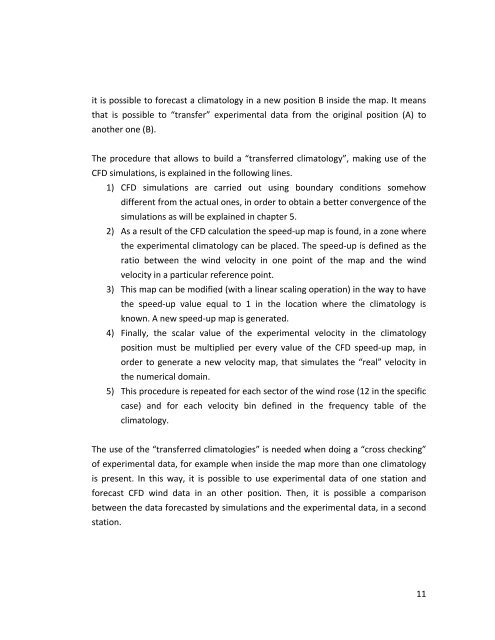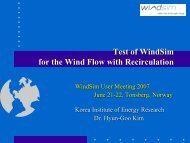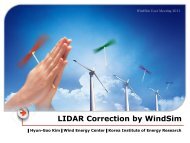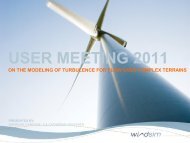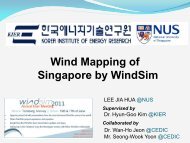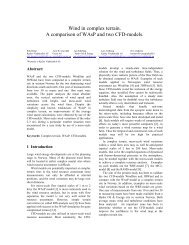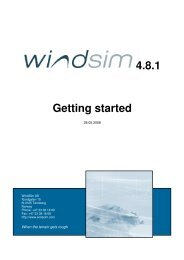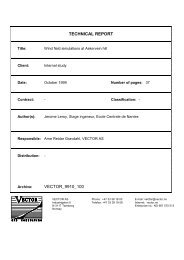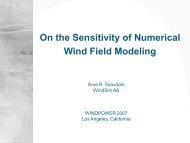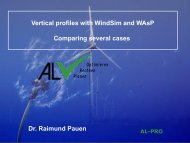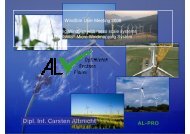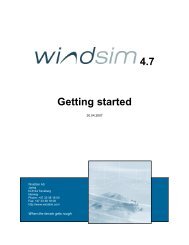wind energy resource evaluation in a site of central italy ... - WindSim
wind energy resource evaluation in a site of central italy ... - WindSim
wind energy resource evaluation in a site of central italy ... - WindSim
You also want an ePaper? Increase the reach of your titles
YUMPU automatically turns print PDFs into web optimized ePapers that Google loves.
it is possible to forecast a climatology <strong>in</strong> a new position B <strong>in</strong>side the map. It meansthat is possible to “transfer” experimental data from the orig<strong>in</strong>al position (A) toanother one (B).The procedure that allows to build a “transferred climatology”, mak<strong>in</strong>g use <strong>of</strong> theCFD simulations, is expla<strong>in</strong>ed <strong>in</strong> the follow<strong>in</strong>g l<strong>in</strong>es.1) CFD simulations are carried out us<strong>in</strong>g boundary conditions somehowdifferent from the actual ones, <strong>in</strong> order to obta<strong>in</strong> a better convergence <strong>of</strong> thesimulations as will be expla<strong>in</strong>ed <strong>in</strong> chapter 5.2) As a result <strong>of</strong> the CFD calculation the speed-up map is found, <strong>in</strong> a zone wherethe experimental climatology can be placed. The speed-up is def<strong>in</strong>ed as theratio between the <strong>w<strong>in</strong>d</strong> velocity <strong>in</strong> one po<strong>in</strong>t <strong>of</strong> the map and the <strong>w<strong>in</strong>d</strong>velocity <strong>in</strong> a particular reference po<strong>in</strong>t.3) This map can be modified (with a l<strong>in</strong>ear scal<strong>in</strong>g operation) <strong>in</strong> the way to havethe speed-up value equal to 1 <strong>in</strong> the location where the climatology isknown. A new speed-up map is generated.4) F<strong>in</strong>ally, the scalar value <strong>of</strong> the experimental velocity <strong>in</strong> the climatologyposition must be multiplied per every value <strong>of</strong> the CFD speed-up map, <strong>in</strong>order to generate a new velocity map, that simulates the “real” velocity <strong>in</strong>the numerical doma<strong>in</strong>.5) This procedure is repeated for each sector <strong>of</strong> the <strong>w<strong>in</strong>d</strong> rose (12 <strong>in</strong> the specificcase) and for each velocity b<strong>in</strong> def<strong>in</strong>ed <strong>in</strong> the frequency table <strong>of</strong> theclimatology.The use <strong>of</strong> the “transferred climatologies” is needed when do<strong>in</strong>g a “cross check<strong>in</strong>g”<strong>of</strong> experimental data, for example when <strong>in</strong>side the map more than one climatologyis present. In this way, it is possible to use experimental data <strong>of</strong> one station andforecast CFD <strong>w<strong>in</strong>d</strong> data <strong>in</strong> an other position. Then, it is possible a comparisonbetween the data forecasted by simulations and the experimental data, <strong>in</strong> a secondstation.11


